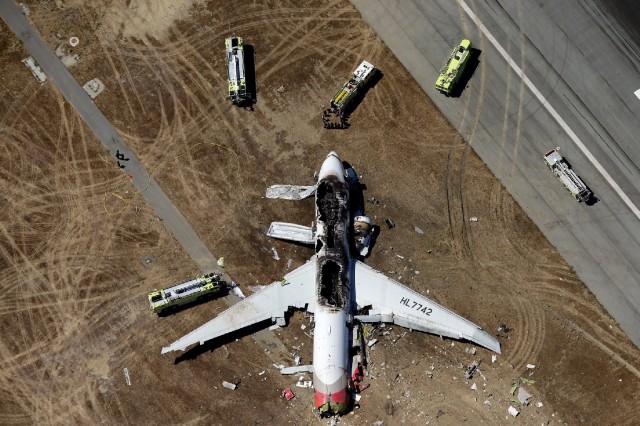Asiana also acknowledged that its crew failed to monitor and maintain a safe air speed, but said inconsistencies in the aircraft's automation logic and deficient warning systems contributed to the failure.
The NTSB previously said the crew showed signs of confusion about the elaborate computer systems of the Boeing 777 that crashed on July 6 and resulted in three deaths.
This is USA Today's story on the latest developments related to the crash of Flight 214:
Asiana Airlines acknowledged for the first time that the "probable cause" of the fatal crash in San Francisco last July was its pilot flying too slow, according to documents federal investigators released today.
However, the airline also said "inconsistencies" in the Boeing 777-200ER's autothrottle contributed to the crash. The airline's positions submitted earlier this month were part of hundreds of pages of documents the National Transportation Safety Board will consider while investigating the crash that killed three passengers and injured more than 200.
Asiana said the plane's navigation equipment "led the crew to believe that the autothrottle was maintaining the airspeed set by the crew" and instead the equipment "disabled the aircraft's minimum airspeed protection." The airline also said test pilots had trouble landing under the same conditions in simulators.
The Asiana documents are just one portion of what the NTSB will consider as it determines the probable cause of the crash and any recommendations resulting from it. Investigators hope to finish the case before the anniversary of the crash July 6.
Asiana Flight 214 slammed into a seawall at the end of the runway in San Francisco before spinning around, breaking into pieces and burning. Three passengers died in the incident, one of whom was run over by a fire truck, and more than 200 were sent to hospitals.
NTSB investigators earlier revealed that the plane was traveling lower and slower than intended when it struck the seawall. The plane was traveling about 119 mph, despite a goal of 158 mph.
But NTSB Chairman Deborah Hersman has said generally that even if there was confusion about how equipment worked, pilots are obligated to monitor their equipment and pay attention to their surroundings, to prevent crashes. She drew no conclusions yet about the Asiana incident.
Asiana Airlines acknowledged for the first time that the "probable cause" of the fatal crash in San Francisco last July was its pilot flying too slow, according to documents federal investigators released today.
However, the airline also said "inconsistencies" in the Boeing 777-200ER's autothrottle contributed to the crash. The airline's positions submitted earlier this month were part of hundreds of pages of documents the National Transportation Safety Board will consider while investigating the crash that killed three passengers and injured more than 200.
Asiana said the plane's navigation equipment "led the crew to believe that the autothrottle was maintaining the airspeed set by the crew" and instead the equipment "disabled the aircraft's minimum airspeed protection." The airline also said test pilots had trouble landing under the same conditions in simulators.
The Asiana documents are just one portion of what the NTSB will consider as it determines the probable cause of the crash and any recommendations resulting from it. Investigators hope to finish the case before the anniversary of the crash July 6.
Asiana Flight 214 slammed into a seawall at the end of the runway in San Francisco before spinning around, breaking into pieces and burning. Three passengers died in the incident, one of whom was run over by a fire truck, and more than 200 were sent to hospitals.
NTSB investigators earlier revealed that the plane was traveling lower and slower than intended when it struck the seawall. The plane was traveling about 119 mph, despite a goal of 158 mph.
But NTSB Chairman Deborah Hersman has said generally that even if there was confusion about how equipment worked, pilots are obligated to monitor their equipment and pay attention to their surroundings, to prevent crashes. She drew no conclusions yet about the Asiana incident.
